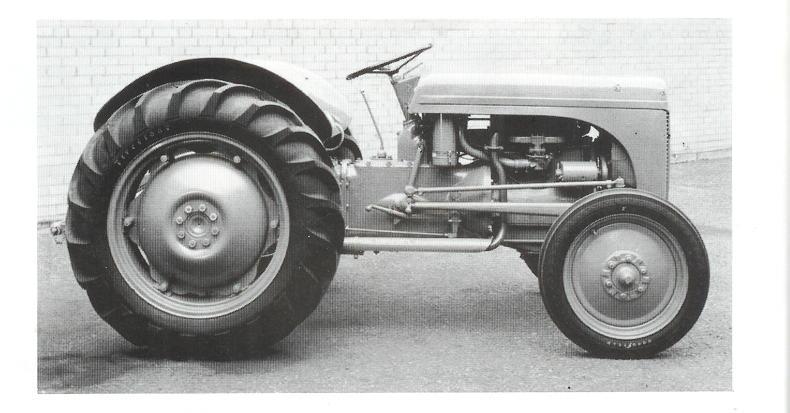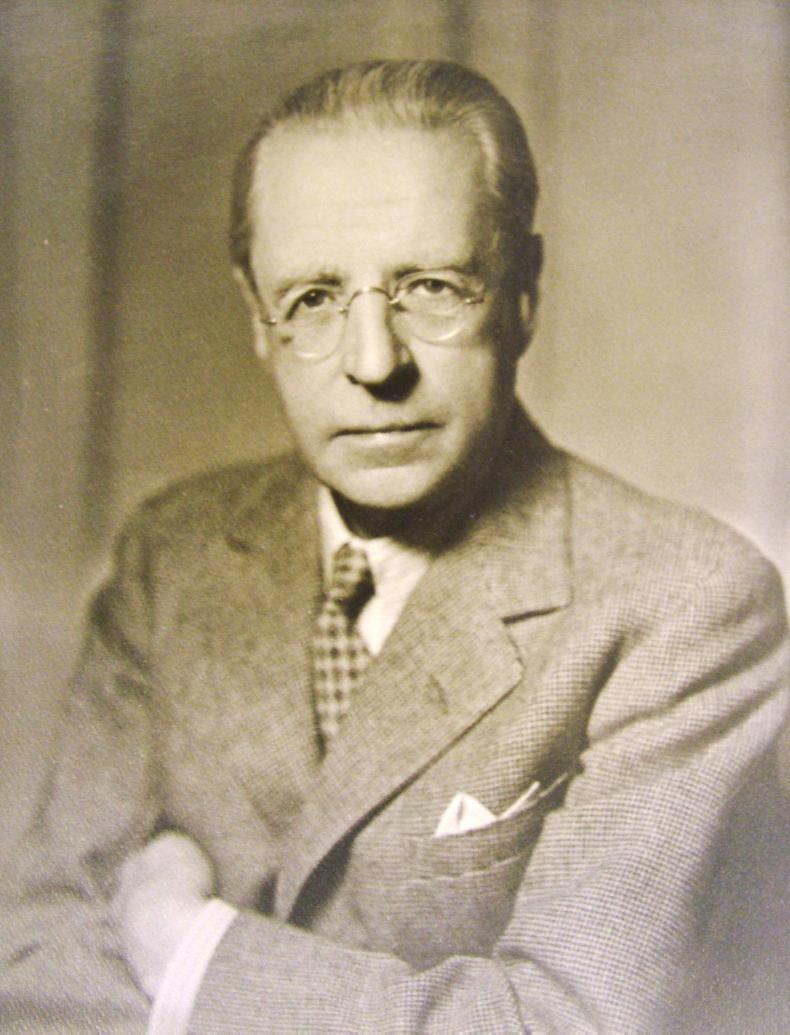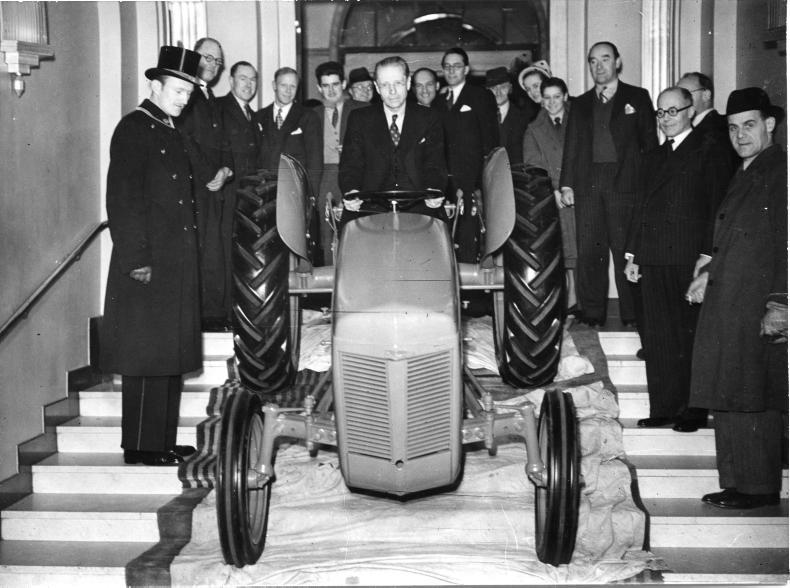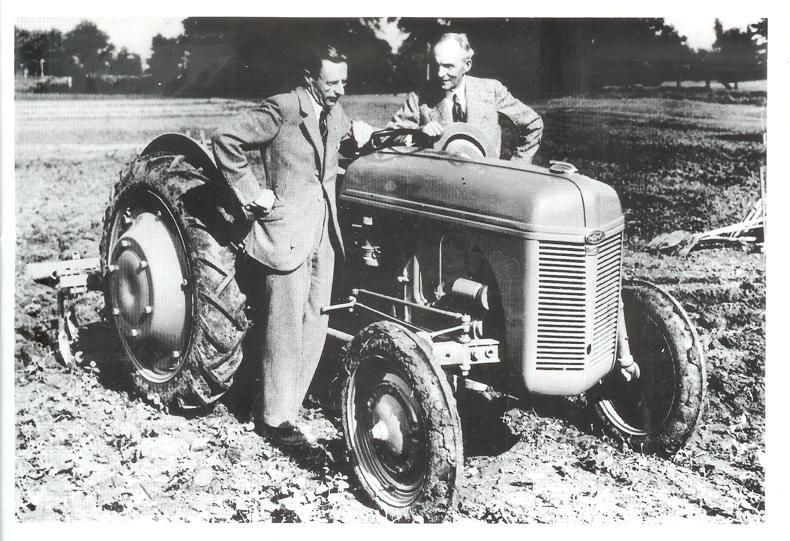There are many versions of history in Northern Ireland (NI) but the importance of Harry Ferguson to farming is beyond challenge. His invention and production of the three-point linkage was to farming in the 20th century what the smartphone is to communication in the 21st century!
Harry Ferguson was born in 1884 outside Dromore, Co Down. His unique talent as an engineer and inventor first came to prominence in 1909 when he designed, built and flew the first plane in Ireland. At the end of his life, he was focused on car development and just after his death, Sterling Moss drove the only four-wheel drive car to win a grand prix in 1961.
Innovator from beginning to end
These events that bookended his life were dramatic in their own right, but his name will be forever associated with the three-point linkage, an invention that transformed global agriculture in the middle of the 20th century. This is the mechanism that allowed a range of implements be attached to the tractor and transported without wheels.

The Ferguson TE 20, this model accounted for 78.5% of tractor sales in 1949.
It meant items like ploughs, grubbers etc could be lifted for transporting and let down for working using a lever. He developed and built a tractor incorporating this mechanism which is in the Science Museum in London.
Ferguson entered a production arrangement with David Brown to build the Ferguson-Brown tractor incorporating this technology but it was a short-term arrangement due to low sales in the pre-war years of the late 1930s. The tractor sold for £224 ,while the more primitive Fordson sold at £140.

Harry Ferguson from Dromore, Co Down, inventor of the three-point linkage which revolutionised farming and is the basis of the modern tractor.
Harry Ferguson’s next step was the big breakthrough commercially. He took the tractor and implements to the US where he got the opportunity to demonstrate to Henry Ford who founded the Ford motor company. This led to the production of the Ford Ferguson 9N, which coincided with the widespread adoption of tractors during the war years for crop production. It was a short-term arrangement though as legal action began in 1944 that ran until 1952 when it settled largely in Ferguson’s favour.
Domination of tractor market
In the meantime, Ferguson started production of the latest incarnation of the tractor, the legendary TE 20 at the Standard motor company in Coventry in 1946 and by 1949, Fergusons accounted for 78.4% of the tractor market in Britain. As well as being a brilliant engineer and inventor, Harry Ferguson was also a superb salesman. He frequently demonstrated the tractor and implements across Britain and Greenmount College, Co Antrim, was one of the venues he used.

Harry Ferguson driving the TE 20 down the steps at Claridges.
He merged the business with Massey Harris in 1953 and in 1954 sold his interest completely. Although he was 70, he didn’t retire but instead the final years of his life were concentrated on car design.
This began shortly after World War II and his vision was to develop a four-wheel drive system that would improve road safety. He and his team developed this for a family type car that also had disk and skid brakes and electric windows – all features of modern cars but only adopted relatively recently. He also used the technology in a formula one and it was fitting that this would be the only four-wheel drive car ever to win a Grand Prix. This happened a few months after Harry Ferguson’s death and, as mentioned, the car was driven by Stirling Moss
Harry Ferguson the person
The Irish Farmers Journal had the opportunity to speak to Peter Warr who worked for Harry Ferguson managing his estate in Gloucestershire and is curator of the Ferguson Family Museum on the Isle of Wight. He recalls a man who was obsessed with precision but really cared for his staff. This, Peter believes, was a clever policy because he always had a well-motivated team who were prepared to go the extra mile.

Harry Ferguson, left, with Henry Ford.
He also recalls that this care was extended to former staff and that he typically would return to NI once a year to visit family and former work colleagues. Harry Ferguson was noted for his attention to detail and was never without a notebook by his side to record ideas and observations, even when he slept. That didn’t just apply to himself but also to his staff as Peter Yarr tells of a request to see your notebook being a regular request when he met him out and about on the estate.
Harry Ferguson died in October 1960 and the Irish Farmers Journal acknowledge the assistance of the Ferguson Family museum and Peter Yarr with this feature.
There are many versions of history in Northern Ireland (NI) but the importance of Harry Ferguson to farming is beyond challenge. His invention and production of the three-point linkage was to farming in the 20th century what the smartphone is to communication in the 21st century!
Harry Ferguson was born in 1884 outside Dromore, Co Down. His unique talent as an engineer and inventor first came to prominence in 1909 when he designed, built and flew the first plane in Ireland. At the end of his life, he was focused on car development and just after his death, Sterling Moss drove the only four-wheel drive car to win a grand prix in 1961.
Innovator from beginning to end
These events that bookended his life were dramatic in their own right, but his name will be forever associated with the three-point linkage, an invention that transformed global agriculture in the middle of the 20th century. This is the mechanism that allowed a range of implements be attached to the tractor and transported without wheels.

The Ferguson TE 20, this model accounted for 78.5% of tractor sales in 1949.
It meant items like ploughs, grubbers etc could be lifted for transporting and let down for working using a lever. He developed and built a tractor incorporating this mechanism which is in the Science Museum in London.
Ferguson entered a production arrangement with David Brown to build the Ferguson-Brown tractor incorporating this technology but it was a short-term arrangement due to low sales in the pre-war years of the late 1930s. The tractor sold for £224 ,while the more primitive Fordson sold at £140.

Harry Ferguson from Dromore, Co Down, inventor of the three-point linkage which revolutionised farming and is the basis of the modern tractor.
Harry Ferguson’s next step was the big breakthrough commercially. He took the tractor and implements to the US where he got the opportunity to demonstrate to Henry Ford who founded the Ford motor company. This led to the production of the Ford Ferguson 9N, which coincided with the widespread adoption of tractors during the war years for crop production. It was a short-term arrangement though as legal action began in 1944 that ran until 1952 when it settled largely in Ferguson’s favour.
Domination of tractor market
In the meantime, Ferguson started production of the latest incarnation of the tractor, the legendary TE 20 at the Standard motor company in Coventry in 1946 and by 1949, Fergusons accounted for 78.4% of the tractor market in Britain. As well as being a brilliant engineer and inventor, Harry Ferguson was also a superb salesman. He frequently demonstrated the tractor and implements across Britain and Greenmount College, Co Antrim, was one of the venues he used.

Harry Ferguson driving the TE 20 down the steps at Claridges.
He merged the business with Massey Harris in 1953 and in 1954 sold his interest completely. Although he was 70, he didn’t retire but instead the final years of his life were concentrated on car design.
This began shortly after World War II and his vision was to develop a four-wheel drive system that would improve road safety. He and his team developed this for a family type car that also had disk and skid brakes and electric windows – all features of modern cars but only adopted relatively recently. He also used the technology in a formula one and it was fitting that this would be the only four-wheel drive car ever to win a Grand Prix. This happened a few months after Harry Ferguson’s death and, as mentioned, the car was driven by Stirling Moss
Harry Ferguson the person
The Irish Farmers Journal had the opportunity to speak to Peter Warr who worked for Harry Ferguson managing his estate in Gloucestershire and is curator of the Ferguson Family Museum on the Isle of Wight. He recalls a man who was obsessed with precision but really cared for his staff. This, Peter believes, was a clever policy because he always had a well-motivated team who were prepared to go the extra mile.

Harry Ferguson, left, with Henry Ford.
He also recalls that this care was extended to former staff and that he typically would return to NI once a year to visit family and former work colleagues. Harry Ferguson was noted for his attention to detail and was never without a notebook by his side to record ideas and observations, even when he slept. That didn’t just apply to himself but also to his staff as Peter Yarr tells of a request to see your notebook being a regular request when he met him out and about on the estate.
Harry Ferguson died in October 1960 and the Irish Farmers Journal acknowledge the assistance of the Ferguson Family museum and Peter Yarr with this feature.










 This is a subscriber-only article
This is a subscriber-only article






SHARING OPTIONS: